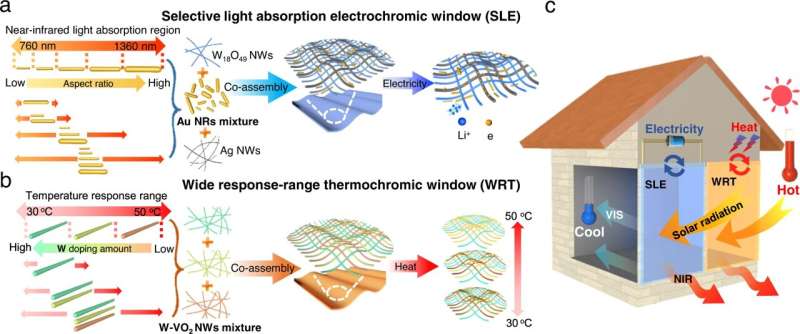Researchers at the University of Science and Technology of China have introduced novel smart windows that dynamically control solar radiation, optimising energy-efficient heat and solar spectrum regulation in buildings.

Installing intelligent windows that can effectively block solar radiation and regulate indoor temperatures is crucial to constructing energy-efficient buildings. However, current smart windows primarily rely on a switch between transparent and opaque states to regulate solar radiation, which often results in reduced visible light transmission, thereby impacting indoor lighting. Additionally, their limited response hampers dynamic and selective solar radiation modulation according to weather changes and preferences.
Researchers at the University of Science and Technology of China (USTC) of the Chinese Academy of Sciences (CAS) have introduced a novel approach for developing smart windows that dynamically regulate solar radiation, enhancing solar spectrum regulation and heat management efficiency in buildings.
The researchers have synthesised and combined gold nanorods with varying aspect ratios based on the unique optical properties of one-dimensional nanomaterials. These nanorods can selectively absorb near-infrared light within a specific wavelength range while allowing visible light to pass through, ensuring adequate illumination in the room. Following this, a blend of differently sized gold nanorods was co-assembled with electrochromic tungsten oxide (W18O49) nanowires and conductive silver nanowires to create an ordered mesh structure. Through the application of an external power supply, smart windows undergo a significant colour transformation. The collaborative effect of the two materials further enhances the windows’ capacity to block solar radiation.
Employing a similar interfacial co-assembly technique, scientists devised thermochromic smart windows (WRT) with an extensive range of responses based on the co-assembly of W-doped vanadium dioxide (W-VO2) nanowires featuring diverse levels of W doping. This approach expands the temperature range within which the windows can respond and enables the thermochromic state of the W-VO2 nanowires to vary in correspondence with the surrounding temperature. Consequently, the colour transformation of the smart windows can be dynamically modulated. These intelligent windows can selectively block solar radiation and actively regulate the room temperature using applied voltage or ambient temperature. Moreover, they offer the potential for significant energy savings, particularly during the hotter months.
The research enhances window optics by manipulating material composition and structure. It enables the efficient production of smart windows for solar spectrum modulation, offering novel solutions in electrochromic and thermochromic window design, preparation, and application.
Reference: Si-Zhe Sheng et al, Nanowire-based smart windows combining electro- and thermochromics for dynamic regulation of solar radiation, Nature Communications (2023). DOI: 10.1038/s41467-023-38353-4






